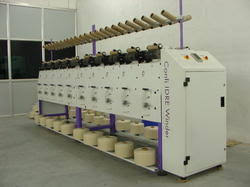Define Warping:
The parallel winding of warp ends from many winding packages (cone, cheese) on to a common package (warp beam) is called warping.
Types of Warping:
1. Sectional or Pattern Warping(conical drum or dresser warping).
2. High speed/ Beam/ Direct Warping(preparatory beam warping).
Sectional or Pattern Warping:
In sectioanal warping sections are made sequentially and because of this the process is rather slow ;it is the practice therefore to produce no more than is required to fill a single weavers beam. the result is that the sectional warping is used mainly for short runs or for complex color patterns.Features of sectional warping:To produce Fancy fabric (stripe/Check)To produce weavers beam from yarns which does not required any sizing material to be applied before weaving.To produce weavers beam of small amount of warp yarn.At first wound section by selection and final weavers beam produce immediately after sectional warping.Production is less, so costly process.A tapered beam or drum is used.
High speed/ Beam/ direct warping:
Denotes the transference of yarns from single-end yarn packages, wound packages, directly to a beam in a one step process. This means that there are an equal number of packages in the creel area as there are ends on the beam, except in the case of a magazine creel. A magazine creel connects the tail of one wound package to the beginning of a new wound package for an easy package transfer. From the wound packages in the creel.
Feature of direct warping:
1. To produce common fabrics in large qualities.
2. To produce weavers beam from single yarn.
3. For high speed production.
4. Weavers beam is produced after sizing.
5. A simple flange beam is used.
6. To produce weavers beam from large amount of yarn.
Types of Direct Warping:
1. Beam Warping: A weaver’s beam may have up to 10,000 ends and if this were to be produced directly it would be necessary to have up to 10,000 creel packages. such an arrangement would be very difficult to accommodate and manage; consequently it is normal practice to produce warps beams which may contain up to about 1000 ends and these are combined at the slashing stage. because of the difficulties involved in combining the ends ,patterned warp beams are seldom produced on the direct system and any pattern that is produced is achieved by combining beams of various colors at the later stage of slashing.
2. Pattern, Band or Drum Warping: Many warps beams are combined in the direct system, this is usually regarded as a high speed process particularly suitable for single color work .providing the warps beams are of single color ,it is possible to combine them to produce simple patterns distributed over the warp width.
3. Ball warping: Ball Warping is an intermediate process for storing yarn for transport , dyeing or reserve; It does not produce a beam. the usual form is a cross wound cheese in which multiple ends are wound at the same time in a ribbon which contains perhaps 50 or 100 ends.
Warping Calculation Formula:
1 Number of ends in the warp,
Count × weight in pounds × 840
=…………………………………………
Length of warp in yds
Easy formula is
Length= Weight in kgs x 1693 x count in Ne










0 Comments